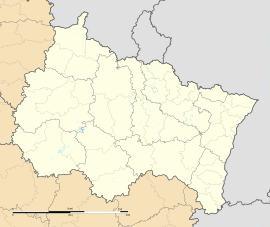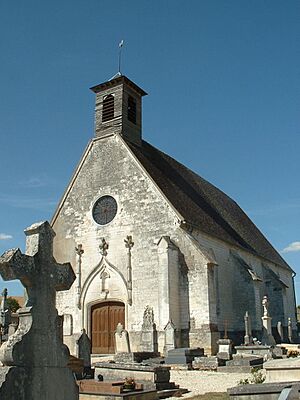Aix-en-Othe facts for kids
Quick facts for kids
Aix-en-Othe
|
||
|---|---|---|
|
Part of Aix-Villemaur-Pâlis
|
||

The Victor Baltard style Hall (19th century)
|
||
|
||
| Country | France | |
| Region | Grand Est | |
| Department | Aube | |
| Arrondissement | Troyes | |
| Canton | Aix-Villemaur-Pâlis | |
| Commune | Aix-Villemaur-Pâlis | |
| Area
1
|
34.76 km2 (13.42 sq mi) | |
| Population
(2021)
|
2,266 | |
| • Density | 65.190/km2 (168.84/sq mi) | |
| Time zone | UTC+01:00 (CET) | |
| • Summer (DST) | UTC+02:00 (CEST) | |
| Postal code |
10160
|
|
| Elevation | 124–246 m (407–807 ft) (avg. 132 m or 433 ft) |
|
| 1 French Land Register data, which excludes lakes, ponds, glaciers > 1 km2 (0.386 sq mi or 247 acres) and river estuaries. | ||
Aix-en-Othe is a town in France. It used to be its own separate town (called a commune). But on January 1, 2016, it joined with other towns to form a new, bigger commune called Aix-Villemaur-Pâlis.
Aix-en-Othe is now the main town of Aix-Villemaur-Pâlis. It is also the center of its local area, known as a canton. The town has won "three flowers" from a national contest for how beautiful and well-kept its towns and villages are.
Contents
Exploring Aix-en-Othe
Aix-en-Othe is in the western part of the Aube area in France. It is about 25 kilometers (15 miles) west of Troyes. It is also about 30 kilometers (18 miles) from Sens.
The town is in the Nosle valley. The Nosle is a small stream that flows into the Vanne river. A major highway, the A5, passes about 2 kilometers (1.2 miles) north of the town. Several local roads also connect Aix-en-Othe to nearby places.
The Nosle stream flows through the town from the southeast to the northwest. It then joins the Vanne river. The area around Aix-en-Othe has many farms. There are also forests to the south and north.
Aix-en-Othe includes several smaller areas called hamlets. These include La Vove, Le Jarc, Druisy, Pitoite, Les Cornees Alexandre, Les Cornees Lalliat, La Bouillant, Le Mineroy, and Les Chevreux.
 |
Paisy-Cosdon | Villemaur-sur-Vanne | Neuville-sur-Vannes |  |
| Rigny-le-Ferron | Chennegy | |||
| Berulle | Boeurs-en-Othe | Villemoiron-en-Othe |
Town Symbols
| Aix-en-Othe has its own special symbol, called a coat of arms. It shows a blue shield with a silver band. There are also golden shapes that look like zigzags. Around the edge, there is a wavy border of silver and blue. At the top, there is a black eagle with two heads on a gold background.
|
Town Leaders
A mayor is the leader of a town or city. Here are some of the people who have been mayor of Aix-en-Othe:
| From | To | Name | Party |
|---|---|---|---|
| 1857 | Fouet | ||
| 1887 | Michant | ||
| 1995 | 2015 | Yves Fournier | PS |
Twin Towns
Aix-en-Othe has a "twinning" partnership with another town. This means they are like sister cities and share culture and friendship.
People of Aix-en-Othe
The people who live in Aix-en-Othe are called Aixois (for boys and men) or Aixoises (for girls and women) in French.
| Historical population | ||
|---|---|---|
| Year | Pop. | ±% p.a. |
| 2006 | 2,348 | — |
| 2011 | 2,450 | +0.85% |
| 2021 | 2,266 | −0.78% |
| Source: INSEE | ||
History and Old Buildings
Aix-en-Othe has many old buildings and structures. Some of these are protected as historical monuments.
Important Buildings
- A House built in the 1800s.
- Several old Hosiery Factories (places where socks and stockings were made). These were built in the 1800s and 1900s.
- A Tanning Mill (a place where animal hides were turned into leather) from the 1800s.
- The Covered Market building, built in 1889.
The Town Hall (where the local government works) also has many old and important items. These include:
- A statue of Christ on the Cross from the 1500s.
- A carving (bas-relief) of Christ from the 1700s.
- Four paintings of saints (Saint Peter, Saint Paul, Saint Nicolas, and Saint Augustin) from the 1600s.
- A special three-part painting (triptych) showing scenes like the Annunciation from the 1500s.
- A special cup (chalice) and plate (paten) used in church, showing scenes from the life of Christ, from the 1600s.
- A cross that holds holy items (reliquary cross) from the 1300s.
- Another chalice from the 1800s.
- The old furniture inside the Town Hall.
Religious Buildings
Aix-en-Othe has two old church buildings that are protected as historical monuments:
- The Chapel of Saint-Avit, built in the 1400s.
- The Church of the Nativity, built in the 1500s. This church has many old and valuable items inside.
Famous People from Aix-en-Othe
Some notable people have connections to Aix-en-Othe:
- Ernest Millot (1836-1891) was an explorer. He traveled to the Red River in Asia in the 1870s. He wanted to find a way to bring goods from China to Vietnam. He was also a mayor in Shanghai, China.
- Jacques Chéreau is a sculptor who was born in Aix-en-Othe. His art has been shown in many cities around the world, including Geneva, Miami, and San Francisco. You can see his work in galleries in Paris and Belgium.
- Joachim du Bellay was a famous French poet. In one of his poems, he wrote about how beautiful "Aiz" (which means Aix-en-Othe) was. He described its fields, rivers, and woods as a lovely place to escape from worries.
Go, see my sweet companion
The sweet pleasures of the Champaigne
Its fields, its waves and woods.
..........
Go and see this beautiful edifice
That nature and artifice
Have embellished with a hundred pleasures.
This is Aiz that beautiful abode
Only to be torn away in less than an hour
Our most ambitious desires.
There, a pleasant sorrow
The certainty fleeing across the plain
Where the hares follow us;
There saintly solitude
Far from trials and business affairs,
Happily we live.
Images for kids
See also
 In Spanish: Aix-en-Othe para niños
In Spanish: Aix-en-Othe para niños







